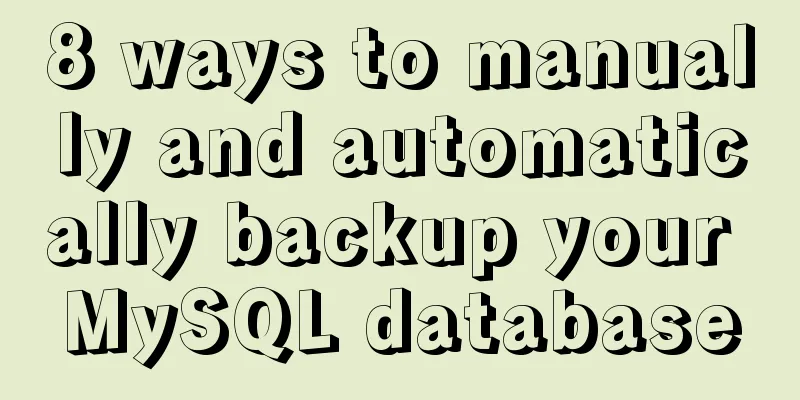8 ways to manually and automatically backup your MySQL database

|
As a popular open source database management system, MySQL has many users. In order to maintain data security, data backup is essential. This article will introduce several data backup methods suitable for enterprises.
MySQL Backup Using MySQLDump mysqldump is a built-in tool for MySQL that allows users to specify different options for backing up databases to files, servers, or even compressed gzip files. The mysqldump utility is flexible, fast, performs advanced backups, and accepts a variety of command-line parameters that allow the user to change the way the database is backed up. The mysqldump utility can be found in c:mysqlbin in Windows operating systems and /usr/local/mysql/bin in Unix/Linux systems. Pass different parameters to the mysqldump utility and it can be used in the following form. mysqldump ---user [user name] ---password= [password] [database name] > [dump file] For manual backup, you only need the password for your MySQL database. Send the command to mysqldump using the p option as the password. For example, to back up all databases, use all databases: mysqldump –u USER –p –all-databases> /mnt/backups/all MySQL Backup Using MySQLpump MySQLpump is similar to mysqldump, producing logical backups that support parallelization. MySQLpump performs all dump-related operations for multiple databases in parallel, which significantly reduces the time taken to perform logical backups. However, MySQLpump does not back up performance_schema, sys schema, and ndbinfo, so you must use --databases to name them, and it also does not dump user account definitions. Shell> mysqlpump –exclude-databases=% --users MySQL Backup with AutoMySQLBackup AutoMySQLBackup can back up single, multiple or all databases on your server. Each database is saved in a separate file, which can be compressed. How to execute it? Just download a file bash script, save it and customize it to your liking and make it executable. Manually run the script: ./automysqlbackup.sh.2.5 Since this script does not support saving the backup folder to a remote location, you may need to mount a remote space or use another technique to upload the files remotely. MySQL backup using mydumper Mydumper is a practical software program that guarantees a fast and reliable multi-threaded MySQL backup process. Mydumper is known to handle large databases very well, providing parallelism. The user needs to create a backup as shown below and then replace the variables ($) with real variables, zip the folder and place it in the preferred location. Mydumper --database=$DB_NAME --host=$DB_HOST --user=$DB_PASS --rows=500000 --compress --build-empty-files --compress-protocol Fast and automatic backups MySQL automatic backup with ottomatik Ottomatik provides an excellent backup solution for your MySQL databases using a backup parachute. Ottomatik supports cloud or local servers. Through the installation script, it automatically installs SSH keys to connect to the Linux server. You can also select multiple servers for the backup job. MySQL Backup Using PHPMyAdmin PHPMyAdmin is a popular application for managing MySQL databases that is free to use. Many service providers use PHPMyAdmin, and you may have it installed without even realizing it. All you need to do to back up your database is open PHPMyAdmin, select the file or folder, and click the "Export" link. Alternatively, there are also options such as "Save As" and "Compress" to save the data locally. MySQL backup using file system snapshots System snapshots can be taken using file systems such as Veritas, LVM, or ZFS. To use the file system snapshot, execute flush tables with a read lock from the client program, and then run mount vxfs snapshot from another shell. Unlock the table from the first client and then copy the files from the snapshot to the target folder and later unmount the snapshot. Backing up by copying table files Back up the MyISAM table by copying the table file to *.MYD, *.MYI files. When using it, you need to stop the server or lock and refresh the relevant tables: Read locks allow other clients to continue querying the table while the files are copied within the database, while flushing ensures that all active index pages are written to disk prior to the backup process. Whether full or incremental, MySQL database backups are essential, and as the size of your database grows, you may also need to change your backup strategy. Summarize The above are 8 methods of manual and automatic backup of MySQL database introduced by the editor. I hope it will be helpful to everyone. If you have any questions, please leave me a message and the editor will reply to you in time. I would also like to thank everyone for their support of the 123WORDPRESS.COM website! You may also be interested in:
|
<<: Do you know how many connections a Linux server can handle?
>>: Vue custom components use event modifiers to step on the pit record
Recommend
In-depth analysis of HTML semantics and its related front-end frameworks
About semantics Semantics is the study of the rel...
Install tomcat and deploy the website under Linux (recommended)
Install jdk: Oracle official download https://www...
Quickly solve the white gap problem (flash screen) when CSS uses @keyframes to load images for the first cycle
Problem explanation: When using the CSS animation...
Detailed explanation of the basic usage of MySQL triggers [create, view, delete, etc.]
Table of contents 1. MySQL trigger creation: 1. M...
Detailed example of creating and deleting tables in MySQL
The table creation command requires: The name of...
Detailed explanation of querying JSON format fields in MySQL
During the work development process, a requiremen...
MySQL fuzzy query statement collection
SQL fuzzy query statement The general fuzzy state...
JavaScript to implement mobile signature function
This article shares the specific code of JavaScri...
How to import SQL files in Navicat Premium
I started working on my final project today, but ...
Detailed explanation of creating, calling and managing MySQL stored procedures
Table of contents Introduction to stored procedur...
JavaScript+html implements random QR code verification on front-end pages
Share the cool front-end page random QR code veri...
MySQL data insertion efficiency comparison
When inserting data, I found that I had never con...
MySQL dual-machine hot standby implementation solution [testable]
Table of contents 1. Concept 2. Environmental Des...
A brief discussion on the problem of Docker run container being in created state
In a recent problem, there is such a phenomenon: ...
MySQL 5.7.21 winx64 free installation version configuration method graphic tutorial
MySQL 5.7.21 winx64 free installation version con...










